Trurra – scat to larrups!
Last Wednesday Wales & West promised that it would be last day of the pneumatic drill. Shop workers took a moment between moments waiting for customers to offer up a prayer, and then stopped, realising that God too would, by now, be numb and deaf from the noise generated by the project to refurbish Trurra’s gas supply. On Thursday, at 8.30am sharp, the drills started again – faith is taking a battering in Boscawen Street! In the Coop customers and assistants are becoming proficient at lip-reading as jokes are bandied round about ‘mole city’ and ‘Great War re-enactments’.
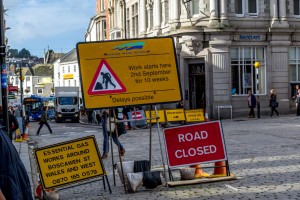 Buses, taxis, cars, trucks and people have milled around, exasperated each other, avoided any major collisions and put the whole place on edge – and Christmas is coming!
Buses, taxis, cars, trucks and people have milled around, exasperated each other, avoided any major collisions and put the whole place on edge – and Christmas is coming!
Meanwhile, up the other end, in Victoria Square, South West Water’s contractor, Balfour Beatty, has expanded its hoarding and public relations effort to fill the whole splatt. River Street resembles one of those wild-west towns that Clint Eastwood was so adept at rendering ghostly with but a glance of his eye and the echo of a harmonica. At one point the most interesting thing happening in town was the speculation about which paperback the man at River Street’s checkpoint was reading while he leaned on his red and white barrier waiting for somebody to re-direct. Eventually, as a good public representative, tenacious and intent upon holding public works to account, I asked him – turned out to be a minor sci-fi classic which examines relationships between astrology and zen – ‘A classic!’ it’s reader declared to nobody in particular – there was nobody about!
But, for all the noise and the disruption and the doleful looks of shop assistants from behind dust-dusted tills, trade has not been too bad. Plenty of people have been in town and the general mood has been wilfully positive – tense chins and determined eyes! I have had discussions about how to achieve easier crossing at the pedestrian refuges for wheelchairs and buggies – ‘How close to the shoulder of a granite sett can you grout before you lose authenticity?’ I have also discussed the possible reinstatement of railings at the bottom of Cathedral Lane and inspected the old leaded holes by which the originals were fixed with a senior highways engineer – he made a mark in his notebook!
The Great Controversy
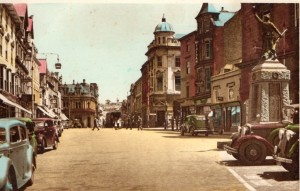 The fact that Boscawen Street is a major element of the Truro Historic Town Centre, a Conservation Area and overflowing with listed buildings, and is therefore the ‘setting’ for those listed buildings, has played no part in this ‘survey’. The object of the exercise is to crush those voices which speak for the integrity of the Conservation Area, and for streets which enable free usage by all in a safe environment, as the tyranny of buses intensifies and the grip of officials on public policy tightens, and to impose a permanent bus stop alongside the pavement adjacent to BHS on the junction of Boscawen Street, St Nicholas Street and King Street. The survey’s originators have not sought advice from the Conservation Officer or the BID Company or Truro City Council in assembling their question sheet, the outcome is imbued with flaws and, naturally, the majority wasn’t just what the Highways Guys thought they would want, because the Highways Guys asked the questions – and so, unless we make a concerted effort, we will see a structure appear in the street, buses parked in the middle of the street, the interplay between vehicles and pedestrians disrupted and trade patterns in the town affected.
The fact that Boscawen Street is a major element of the Truro Historic Town Centre, a Conservation Area and overflowing with listed buildings, and is therefore the ‘setting’ for those listed buildings, has played no part in this ‘survey’. The object of the exercise is to crush those voices which speak for the integrity of the Conservation Area, and for streets which enable free usage by all in a safe environment, as the tyranny of buses intensifies and the grip of officials on public policy tightens, and to impose a permanent bus stop alongside the pavement adjacent to BHS on the junction of Boscawen Street, St Nicholas Street and King Street. The survey’s originators have not sought advice from the Conservation Officer or the BID Company or Truro City Council in assembling their question sheet, the outcome is imbued with flaws and, naturally, the majority wasn’t just what the Highways Guys thought they would want, because the Highways Guys asked the questions – and so, unless we make a concerted effort, we will see a structure appear in the street, buses parked in the middle of the street, the interplay between vehicles and pedestrians disrupted and trade patterns in the town affected.
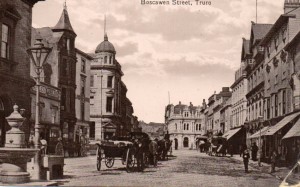 We have observed during the tenure of the wooden horse that passengers dismount the charabanc and immediately disperse in all directions across the fenced, pneumatically challenged and crowded street – most of the vehicles avoiding conflicts have been professionally driven – buses, taxis, delivery trucks. Back beside the St Nicholas/King Street junction it will be much different – and we will have lost the parallel kerb lines that carry the eye from Coinage Hall to Barclays (or vice verse) and which inform probably the best known, brand-sensitive image of Truro and which is also the most significant ‘delta in the tributaries of pedestrian flows’ that make the town work.
We have observed during the tenure of the wooden horse that passengers dismount the charabanc and immediately disperse in all directions across the fenced, pneumatically challenged and crowded street – most of the vehicles avoiding conflicts have been professionally driven – buses, taxis, delivery trucks. Back beside the St Nicholas/King Street junction it will be much different – and we will have lost the parallel kerb lines that carry the eye from Coinage Hall to Barclays (or vice verse) and which inform probably the best known, brand-sensitive image of Truro and which is also the most significant ‘delta in the tributaries of pedestrian flows’ that make the town work.
Apart from wishing to distance myself from such crude survey work, I would request that the Society reaches a view about the principle of imposing such a structure, and considers how it will communicate its view publicly.
Sitting by the River
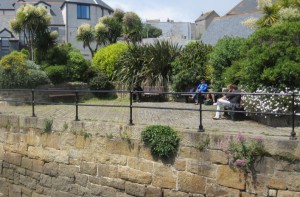 I was able to have a lengthy conversation (well, my interlocutor might not accept this description – ‘lecture’ or ‘rant’ might better describe his experience!) with Mr Phillips, who is the senior planner at Circuit House (the Truro planning office). We covered much ground, touched on old favourites including 117 Kenwyn St and 15/16 St Clement Street, and I asked him to consider if the issue of the removal of the Police Station from its present site in relation to future operational efficiency and accessibility, might be a material consideration in determining the application for 57 residential dwellings on the Trafalgar Roundabout.
I was able to have a lengthy conversation (well, my interlocutor might not accept this description – ‘lecture’ or ‘rant’ might better describe his experience!) with Mr Phillips, who is the senior planner at Circuit House (the Truro planning office). We covered much ground, touched on old favourites including 117 Kenwyn St and 15/16 St Clement Street, and I asked him to consider if the issue of the removal of the Police Station from its present site in relation to future operational efficiency and accessibility, might be a material consideration in determining the application for 57 residential dwellings on the Trafalgar Roundabout.
We also discussed the ongoing saga of the river bank at Boscawen Bridge and the Compton Castle. The ‘boat’ is moored in Truro Harbour and dues are paid to the Truro Harbour Authority. The bank is in the ownership of Cornwall Council, and is currently leased to a company called Porthia, and sub-let to a ‘pop-up’ catering facility which is both popular and the source of concern about intrusive odours. Notwithstanding any applications which may arise in the near future Mr Phillips and I discussed the long-term outcome for this area. I recalled with a shudder the erstwhile proposal to site a rotunda-like office block there, and also that this is where the River Kenwyn sluice gate was situated (you can still see the motor over the bridge parapet) – a device for keeping the river channel clear which we should keep in mind and allow to be able to bring it back into use at some time in the future.
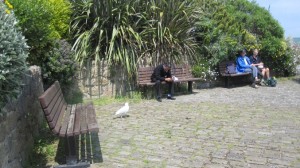 I was reminded of the area to the rear of the Abbey Pool at Penzance (just behind the Dry Dock) which has been discreetly treated to provide a quiet and planted place amongst the urban bustle – and I feel that, perhaps together with a more appropriate ship – perhaps a rigged brigantine such as you might have seen discharging at Lemon Quay – we should make a stand. This is the only place where the River is visible in the town centre and we should offer it to one and all in a non-commercial manner – it connects us both to the world and to the rhythms of the tide and nature. An appropriate ship could also provide a ‘Welcome’ feature for bus-visitors, and an outreach for the Tourist Information Bureau.
I was reminded of the area to the rear of the Abbey Pool at Penzance (just behind the Dry Dock) which has been discreetly treated to provide a quiet and planted place amongst the urban bustle – and I feel that, perhaps together with a more appropriate ship – perhaps a rigged brigantine such as you might have seen discharging at Lemon Quay – we should make a stand. This is the only place where the River is visible in the town centre and we should offer it to one and all in a non-commercial manner – it connects us both to the world and to the rhythms of the tide and nature. An appropriate ship could also provide a ‘Welcome’ feature for bus-visitors, and an outreach for the Tourist Information Bureau.
Sustainable Development?
My attention has been drawn to a lamentable development which is unseen but is an object lesson in how not to do things, and a warning about the seductiveness of fashion. In Union Street, opposite the Crown Court, is a small group of bungalows – Williams Court. They are alms houses managed successfully by the Williams Trust. They are relatively modern, being replacements for the original houses which were consumed by the development of Carrick offices, Tescos and adjacent grey-brick boxes in the 1970s. Behind Williams Court is an area on to which backs some houses in Pydar Street, the Leats and Castle Street.
One of the strip gardens in Castle Street was given consent some years ago for five ‘eco’ homes. These are modernist boxes – containers – piled on each other to create two floor small dwellings with all the eco-trimmings. The site is very narrow and accessed as if from the back garden gate from the Williams Court rear yard. The access to the dwellings is via a still-water feature partially enclosed with concrete paving slabs. With no external lighting, this is hazardous, as well as being an environmental risk. Inside, the units are unfinished, the staircases are extremely narrow, the living space very constrained and the eco-commitment to natural light means that they lack privacy. The whole development is cramped, includes no parking spaces, is unneighbourly in relation to the bungalow to the rear, and should never have been granted consent. The neighbours are aghast at it, and, unfinished as it is, and with no security, it has been squatted, vandalised and neglected. It is in the Conservation Area, where, neighbours suggest (having consulted estate agents) it is a blight. Needless to say, the small cottage in Castle Street whose garden it occupies, has no amenity area, and is, itself, reduced in quality as a result.
As well as dealing with the plight of neighbours I am concerned about the need to marry the sensible commitment to natural light, sustainable power and heat, reducing the footprint and so on with the principles of good design, so that, in Truro we may not only provide modern living quarters but do so in a way which enhances life by celebrating elegance, clarity and good aesthetics – if we are to make a statement of our time, then let it be a quality statement, the best we can do, not the expedient or the exploitative, or the cheap and opportunistic. Let us also realise that living requires an environment, not just a bed and a toilet – it is about the spirit as much as the body, and it needs space, contrast, proportion, an evident linkage to topography, geology and soil, to land, materials and indigenous flora and fauna. These boxes must be a lesson for us. The System which allowed them must be self-critical and must, as well as being allowed to make mistakes, be invested in to learn and to avoid repetition of those mistakes. This is a serious challenge to Cornwall Planning Department – performance indicators do not achieve quality, they merely validate process, and process is no substitute for judgement.
BB


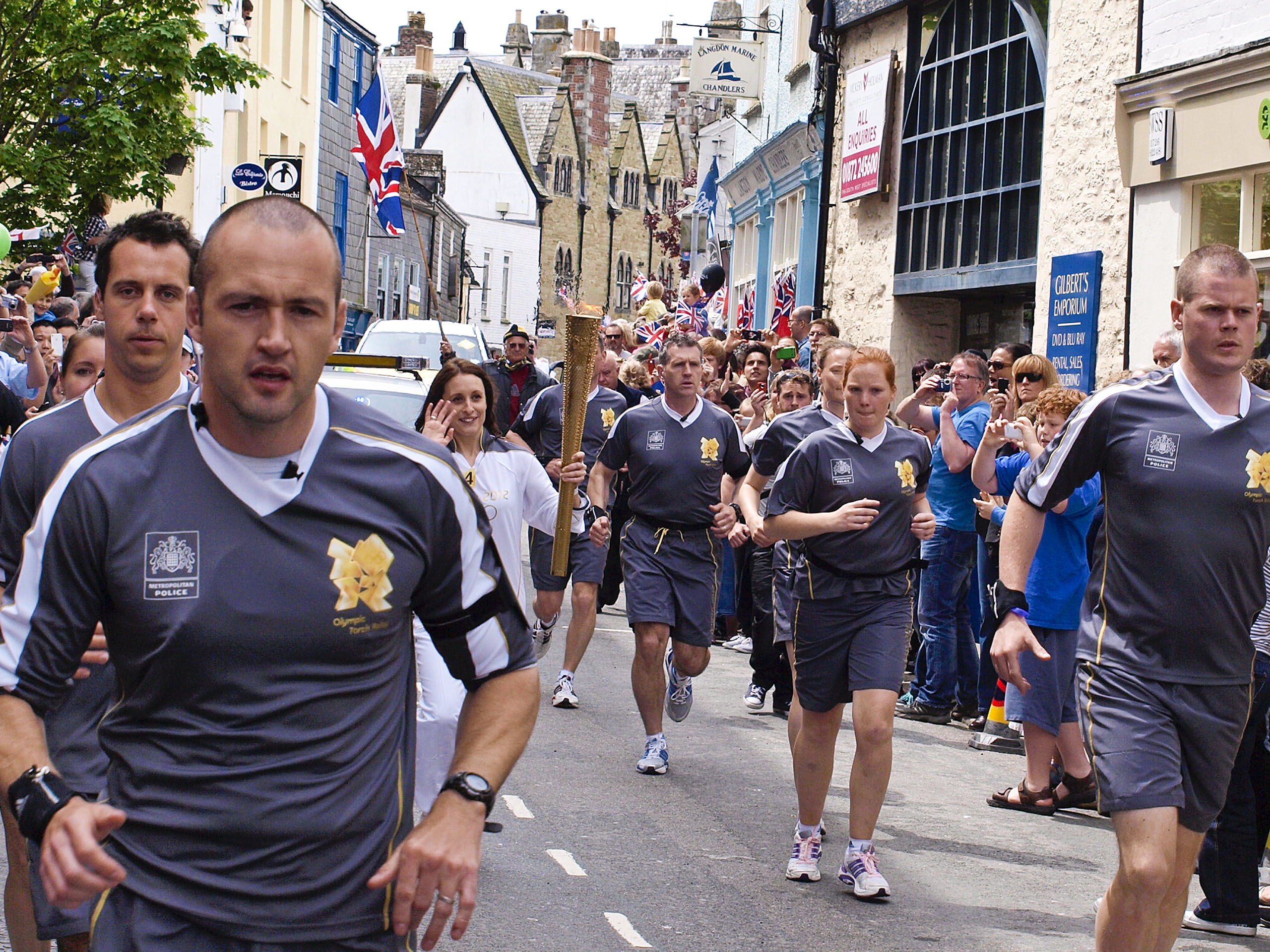
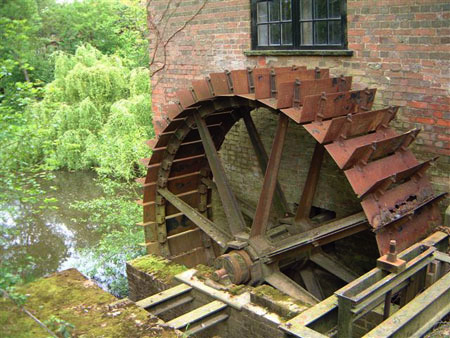




Recent Comments